Weaker Inflation Causes Policy Pivot Hopes To Soar

Inside This Week’s Bull Bear Report
- Market Surges On Policy Pivot Hopes
- Weaker Inflation Print Finally Arrives
- How We Are Trading It
- Research Report – The Policy Pivot May Not Be Bullish
- Youtube – Market Recap With Adam Taggert
- Stock Of The Week
- Daily Commentary Bits
- Market Statistics
- Stock Screens
- Portfolio Trades This Week
Market Surges On Policy Pivot Hopes
Last week, we discussed the markets dive following the hawkish comments from Jerome Powell stating it was “‘premature’ to discuss a pause in rate increases,” which sent stocks tumbling as the “policy pivot” hopes got crushed. However, what a difference a week can make as a weaker inflation print led to a massive surge in the stock market on Thursday.
From a technical perspective, the market tested and held crucial support again at the 20-dma after the FTX (cryptocurrency) blowup on Wednesday. The subsequent rally off support turned our MACD “buy signal” higher, keeping it intact, and the market cleared critical resistance at the 100-dma. Such now sets the stage for a rally to the 200-dma between 4000 and 4100.
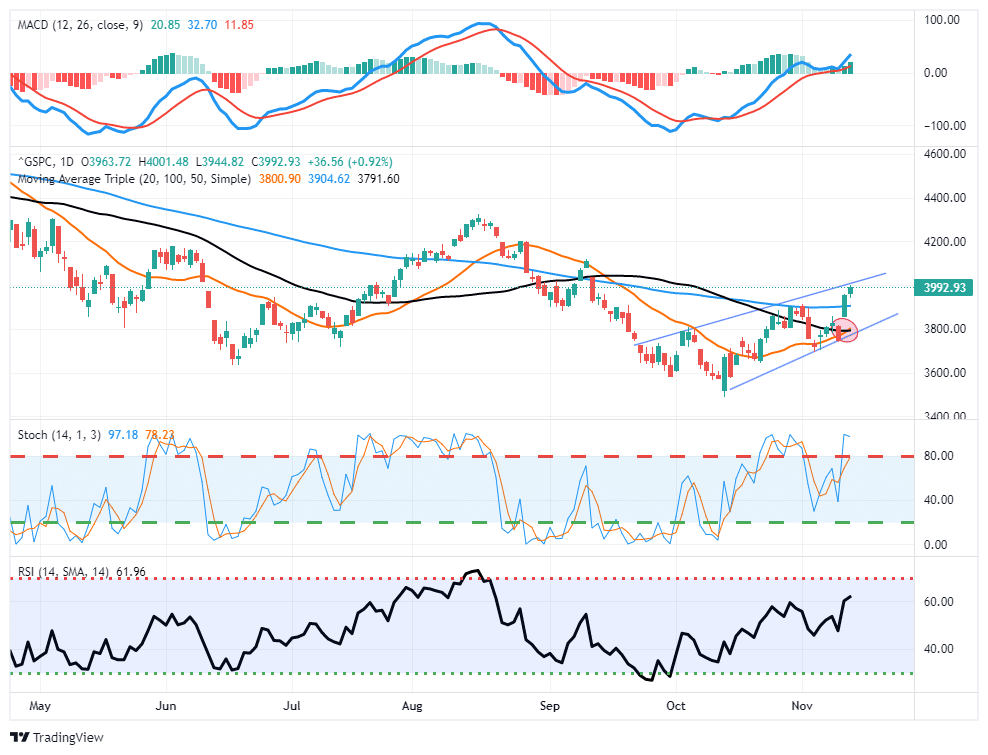
The surge in asset prices also cleared levels that are now forcing short-sellers to cover positions which will add “fuel to the rally” over the next few days. As noted by Goldman Sachs, CTAs bought $43BN last week and $79BN the previous month. Now that we are above the short-term trigger, Goldman calculates a whopping $38 billion to buy over the next week and substantially more (green line) if the market is up big. The chart below shows that the bank expects more than +$79 billion of net buying over the month.
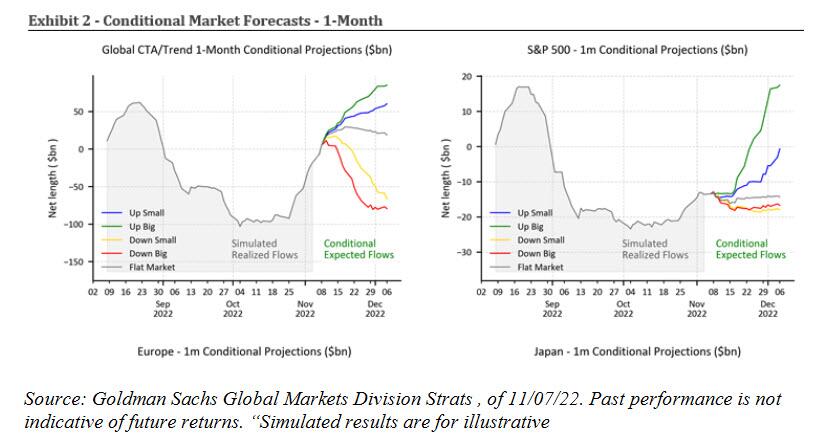
As we will discuss in more detail today, while weaker inflation was evident in the latest report, such does not mean the Fed will stop hiking interest rates. However, as discussed last week following the FOMC meeting, the Fed has already clarified that they will slow the rate hike pace. Such was a point made by Philadelphia Fed President Patrick Harker on Thursday:
“In the upcoming months, in light of the cumulative tightening we have achieved, I expect we will slow the pace of our rate hikes as we approach a sufficiently restrictive stance.”
Moving from 75bps rate hikes to 50bps in December is still a significant “aggressive action” that will impact economic growth in 2023.
As we will discuss, the surge in markets, while much needed, is likely another opportunity to reduce risk and rebalance portfolios as we head into 2023. Slower economic growth and falling inflation do not support currently elevated earnings and profit margins.
Need Help With Your Investing Strategy?
Are you looking for complete financial, insurance, and estate planning? Need a risk-managed portfolio management strategy to grow and protect your savings? Whatever your needs are, we are here to help.

Weaker Inflation Print Finally Arrives
Over the last few months, we discussed that weaker inflation was coming as the Fed hiked rates, economic growth slowed, and stimulus got drained from the system. While inflation has been stubborn, weaker inflation, or rather disinflation, is starting to show up in the economy. One point previously made was about the impact of inflation on household spending. To wit:
“Health care costs and housing, as shown below, have contributed to inflation pressures, but the real pressure is in the daily living costs of Americans. Healthcare and housing, or rent, are fixed for most Americans through contractual agreements. Food, energy, and everything Americans purchase daily is sapping their disposable incomes.”
Given that wages have not kept up with inflation, it is unsurprising we are seeing inflation, Iess, healthcare, and housing, dropping more rapidly as consumer demand weakens.
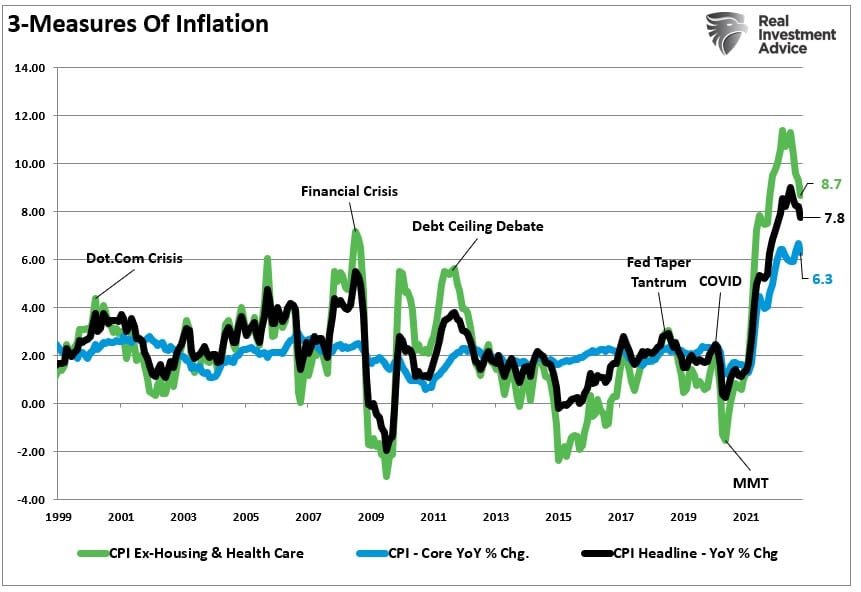
Core inflation has remained “more sticky” due to the lag effect of data inputs. However, over the next few months, we will see core inflation begin to reflect weaker spending and economic growth. As shown, every category, except recreation, fell in the last month, including energy. Importantly, this is the first crack in the “housing,” or “homeowners equivalent rent,” component, which is the most significant factor affecting inflation.
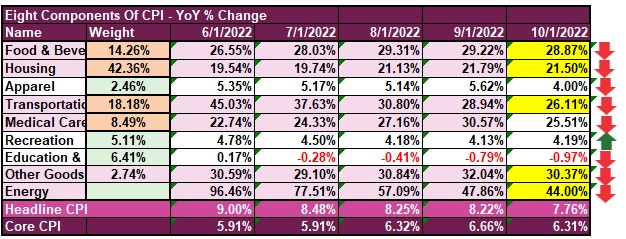
Given the rapid decline in many national “rent indexes,” we are likely at the beginning of a reversion in rents which will continue to suppress inflation over the next several months.
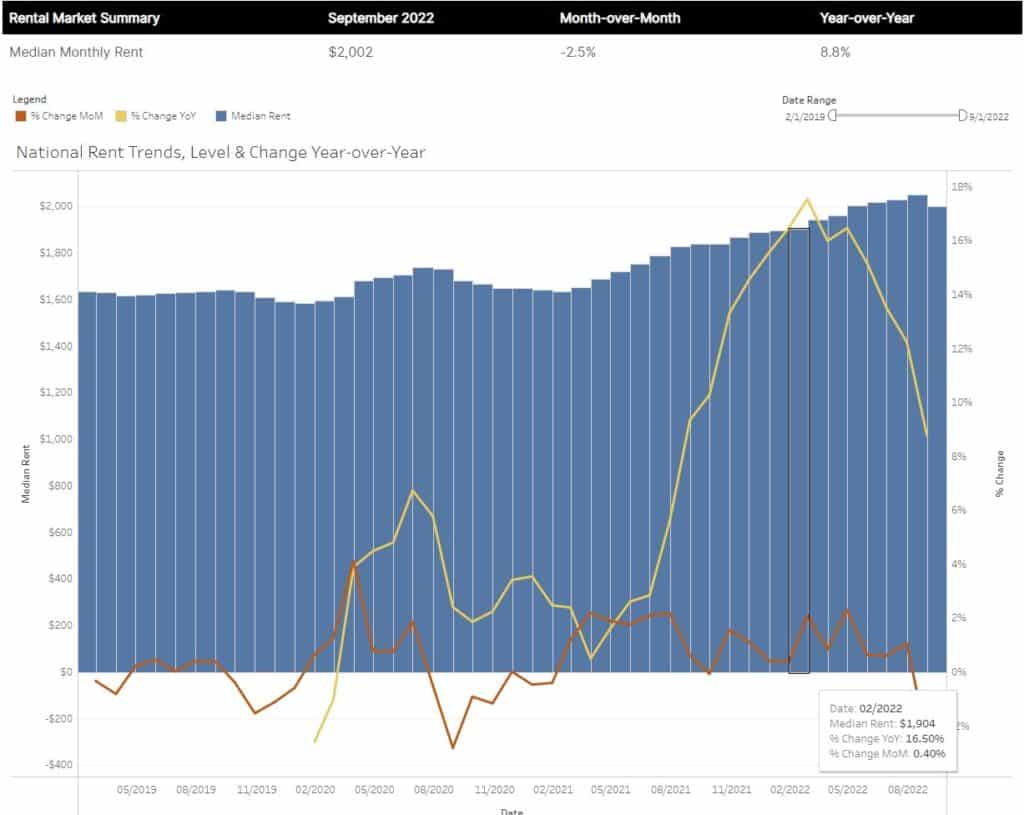
Suppose we assume higher interest rates and weaker economic growth slows the pace of inflation to a historical average of 0.2% monthly. In that case, we should expect inflation to fall toward the Fed’s long-term target by the end of 2023.
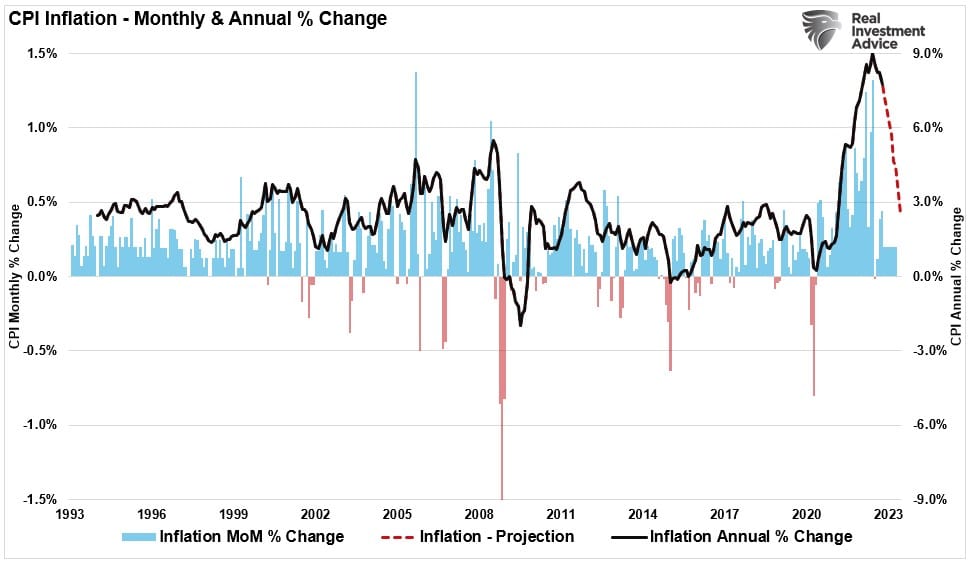
Given the historical relationship between the economy and long-term interest rates, such suggests that yields will fall over the next 12-18 months.
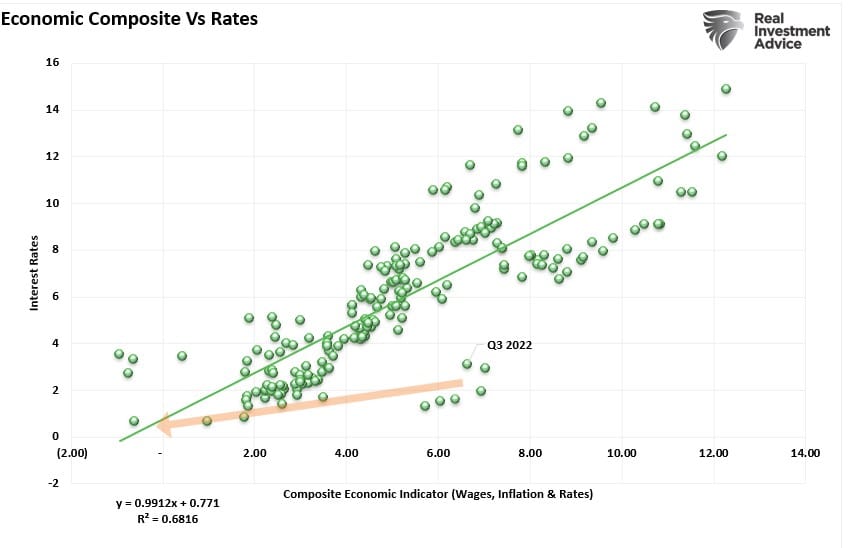
What this data continues to suggest, other than owning long-dated Treasuries, is that the Fed is close to the end of hiking rates than not.
However, that does not mean the Fed will stop where they are today.
Weaker Inflation Won’t Stop The Fed
While the market surged on weaker inflation data, with the bulls assuming the Fed will start to “pivot,” there is little evidence that is the case. The Fed remains quite clear on its intent to continue to combat inflation at the expense of the economy. Such was noted in Powell’s recent statements following last week’s FOMC meeting. To wit:
“Even so, we still have some ways to go, and incoming data since our last meeting suggest that the ultimate level of interest rates will be higher than previously expected.
The historical record cautions strongly against prematurely loosening policy. We will stay the course until the job is done.”
What is most crucial about that statement is the Federal Reserve had the inflation data last week before the policy announcement. As such, even though they knew inflation had moderated somewhat, they remained extremely hawkish in their policy statement.
“We think there’s some ground to cover but before we meet that test and that’s why we say that ongoing rate increases will be appropriate, and as I mentioned, incoming data between the meetings, both a strong labor market report but particularly the CPI report (which they had), do suggest to me that we may ultimately move to higher levels than we thought at the time of the September meeting.
Remember though that we still think there’s a need for ongoing rate increases and we have some ground left to cover here and cover it we will.
While bulls rallied the market hard on Thursday following the report, the Fed remains focused on its inflation fight. Therefore, hopes for a “policy pivot” will likely disappoint in the weeks ahead.
More importantly, as we have noted previously, a surging stock market is precisely the opposite of what the Federal Reserve wants.
Fed Wants Tighter, Not Looser, Financial Conditions
Higher asset prices represent looser, not tighter, monetary policy. Rising asset prices boost consumer confidence and act to ease the very financial conditions the Fed is trying to tighten. While financial conditions have tightened recently between higher interest rates and surging inflation, they remain low. Such is hardly the environment desired by the Fed to quell inflation.
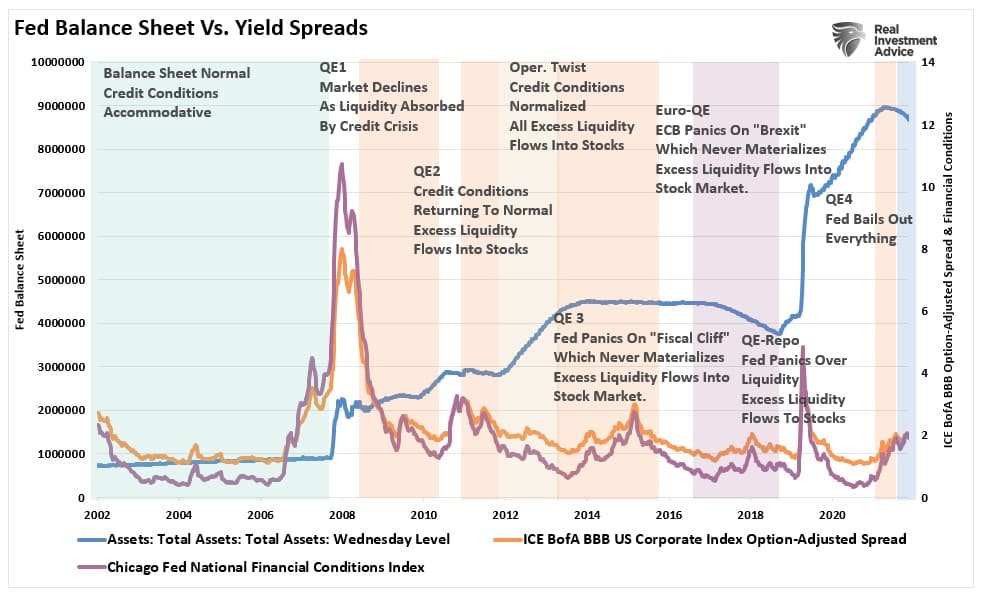
Tighter financial conditions are a function of several items:
- A stronger US dollar relative to other currencies (Check)
- Wider spreads across bond markets (There is no credit stress currently)
- Reduction in liquidity (Quantitative Tightening or QT)
- Lower stock prices.
The more bullish market participants should be aware the Fed is ultimately pushing for lower stock prices. The Fed is removing liquidity by reducing its balance sheet twice as fast as in 2018. For those who don’t remember, the last QT ended in a 20% market plunge over three months. Today, even with weaker inflation, QT is not ending anytime soon.
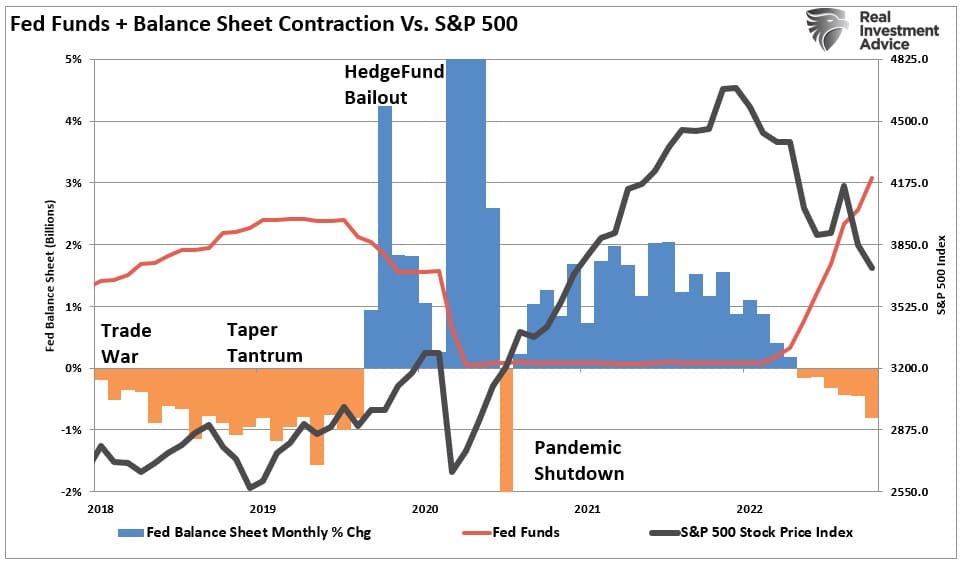
Therefore, it will not be surprising to see Federal Reserve speakers try and swat down asset prices with continued hawkish rhetoric. As far as a “pivot” goes, that still seems to be quite a long way off.
“And the last thing I’ll say is that I would want people to understand our commitment to getting this done. And to not making the mistake of not doing enough or the mistake of withdrawing our strong policy and doing that too soon. So those, I control those messages and that’s my job.“
We suggest selling into rallies to raise cash, reduce exposures, and rebalance risk accordingly.
Not Getting The Bull Bear Report Each Week In Your Mailbox? Subscribe Here For Free.
How We Are Trading It
While the market surged following the weaker inflation report, we suspect the rally will get sold into as we head into year-end. Such is because there are a lot of “trapped longs” in the market just hoping for an opportunity to get out at a better level. However, we will undoubtedly use the rally to rebalance portfolio risks further and reduce some exposure near term.
A critical aspect of this week’s action was the longer-dated yields, which plunged below 4% on the 10-year Treasury. We noted that even though the Fed was hiking rates, bond yields had become capped at this upper range. The weaker inflation figures suggest we have likely seen both the peak in inflation and economic growth, which, as shown above, clearly means lower yields are on the way. As such, we will start looking for opportunities to increase the duration of our portfolio, which, as shown below, is roughly 45% allocated to bond investments. However, most of that exposure has been very short-term yields, with only 9% allocated to longer-duration bonds. We will soon begin shifting that allocation to take advantage of falling yields into next year, which should coincide with an economic recession.

The rally this week, while outsized, is in the context of what we have discussed over the last four weeks. Our target for the rally remains 4000 to 4100, or roughly where the 200-dma currently resides. There is very little news over the next couple of weeks as earnings season is mostly behind us. However, we will start seeing mutual fund redemptions in the first half of December, which could put some pressure on stocks before the traditional year-end “Santa Rally.”
So far, seasonality continues to operate within historical parameters, but such does not mean that things can’t go awry very quickly. This market is not one to be trifled with short-term. Therefore, continue to manage risk accordingly for now.
- Tighten up stop-loss levels to current support levels for each position.
- Hedge portfolios against significant market declines.
- Take profits in positions that have been big winners
- Sell laggards and losers.
- Raise cash and rebalance portfolios to target weightings.
See you next week.
Research Report

Market Recap – With Adam Taggert
Subscribe To Our Youtube Channel To Get Notified Of All Our Videos
Stock Of The Week In Review
This week’s screen was inspired by Lance’s recent article Fed Rate Hikes Approaching The “Breaking Point.” He explains that the Fed is at risk of over-tightening into a slowdown because it relies on lagging economic indicators. While reviewing the Fed’s track record of hiking rates, he writes,
The problem, as history clearly shows, is the Fed never achieves a soft landing. Rather, the inflationary problem it is trying to combat becomes a “deflationary recession” rather quickly.
If we are indeed headed for a recession, small and mid-cap stocks should be on your radar. They tend to be the first to bottom and usually outperform the S&P 500 over the following 12 months. We leverage the SimpleVisor screener again this week to search for small and mid-cap value stocks.
Here is a link to the full SimpleVisor Article For Step-By-Step Screening Instructions.
Here is one of the stocks from the scan.
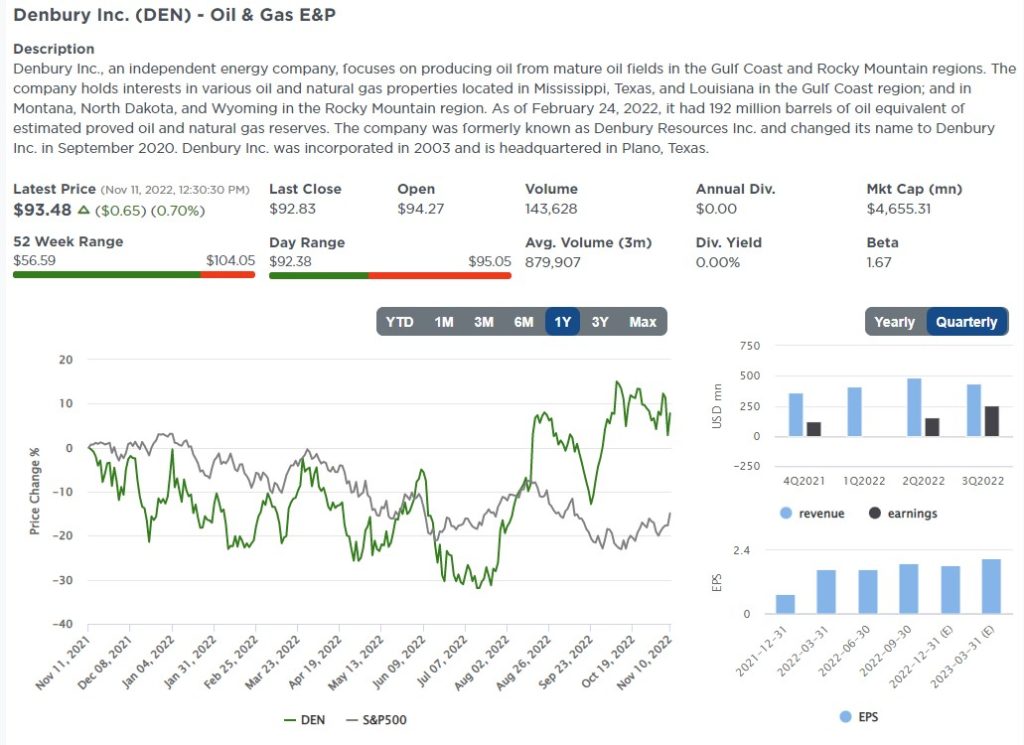
Login to Simplevisor.com to read the full 5-For-Friday report.
Daily Commentary Bits
Monetary Headwinds Accenturate Q4 Risks
Remember the bullwhip effect? Retailers and wholesalers massively over ordered merchandise following supply chain shocks just as the stimulus sugar-high began waning. The missteps led to a severe inventory problem at several retailers, who warned of impacts to margins as they get ready clean up mistakes.
The holiday season is quickly approaching, which means it’s time for retailers to buckle down on their inventory overhang. How so? Deals! And lots of them. Discounts may get competitive as retailers fight to move inventory with discretionary incomes still being squeezed by inflation. Some could be in store for some large losses as massive brands race to liquidate high cost inventory in a demand-constrained environment. Per Bloomberg yesterday:
“Even just in the past three days, we’ve seen some of the biggest or most valuable brands in the world contact us for help with excess inventory,” Kaplan said. “It’s a full tidal wave at this point. We need the customer to be spending, and until that happens, the product’s not going to move.”
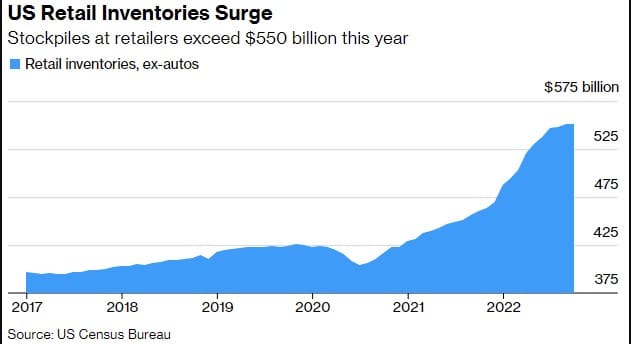
Click Here To Read The Latest Daily Market Commentary (Subscribe For Pre-Market Email)
Bull Bear Report Market Statistics & Screens

SimpleVisor Top & Bottom Performers By Sector
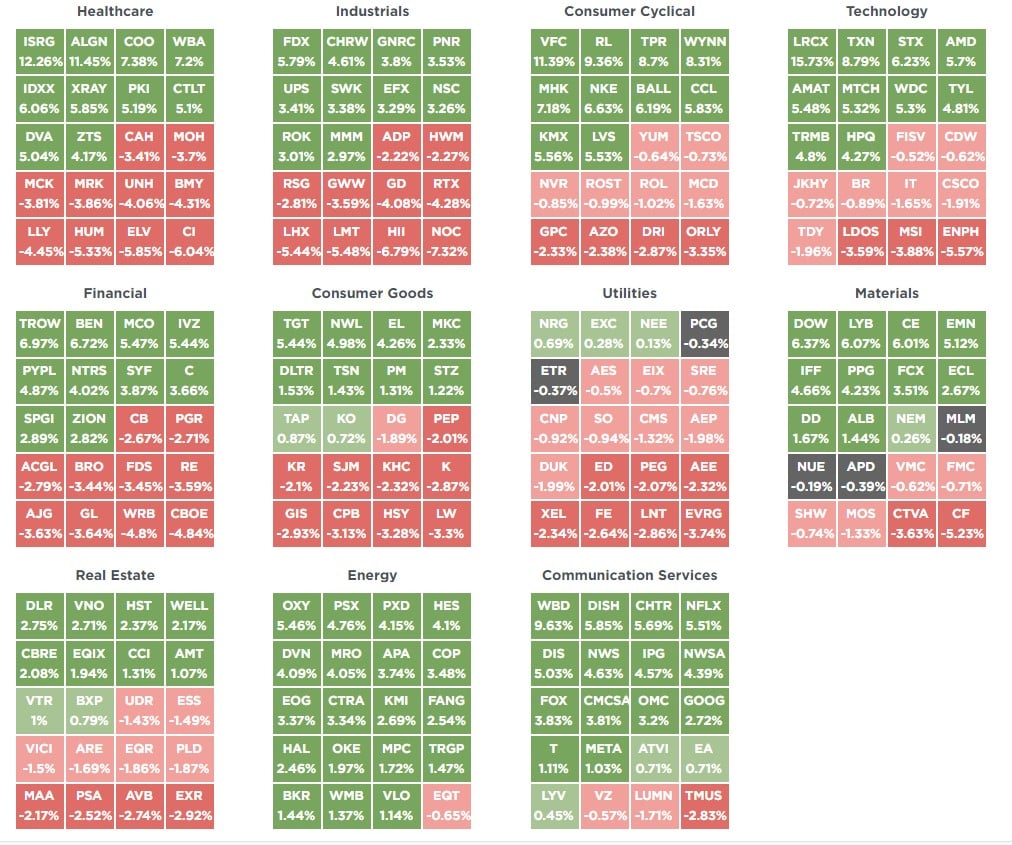
S&P 500 Tear Sheet
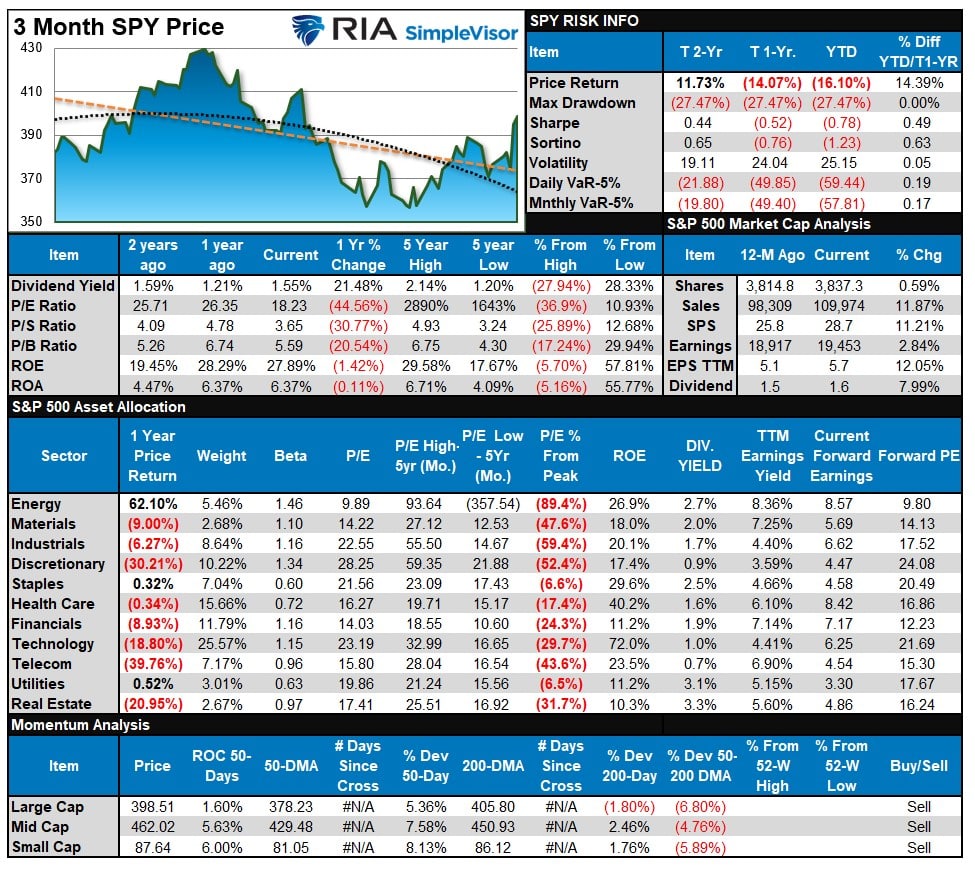
Relative Performance Analysis
The market surged last week as weaker inflation data sparked a “bid to cover” the most shorted and hated equity names. The rotation to “deflationary” stocks, i.e., Technology, has pushed that sector to more extreme overbought levels. However, as I explained last week, the performance lag was likely to reverse, as seen this week. The sharp move has pushed most markets and sectors into extremely overbought territory, suggesting some profit-taking is likely well warranted.
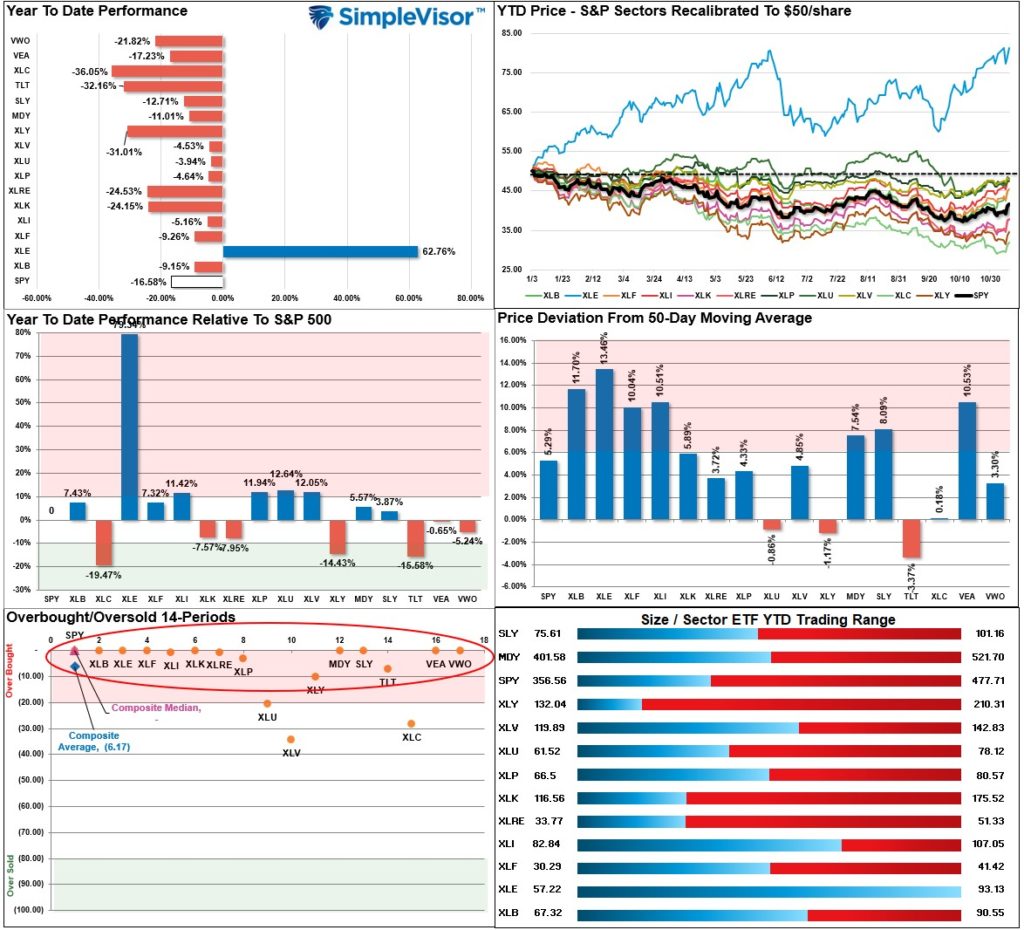
Technical Composite
The technical overbought/sold gauge comprises several price indicators (RSI, Williams %R, etc.), measured using “weekly” closing price data. Readings above “80” are considered overbought, and below “20” are oversold. Markets tend to peak when readings are at 80 or above, which suggests profit-taking and risk management are prudent. The best buying opportunities exist when readings are 20 or below.
The current reading is 51.48 out of a possible 100 and rising. Remain long equities for now.
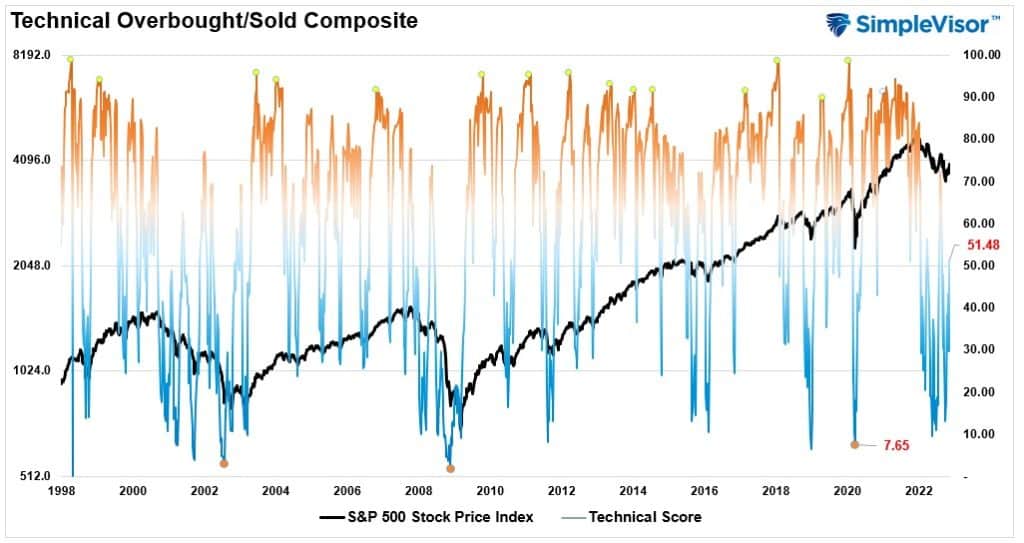
Portfolio Positioning “Fear / Greed” Gauge
The “Fear/Greed” Gauge is how individual and professional investors are “positioning” themselves in the market based on their equity exposure. From a contrarian position, the higher the allocation to equities, the more likely the market is closer to a correction than not. The gauge uses weekly closing data.
NOTE: The Fear/Greed Index measures risk from 0 to 100. It is a rarity that it reaches levels above 90. The current reading is 56.77 out of a possible 100.
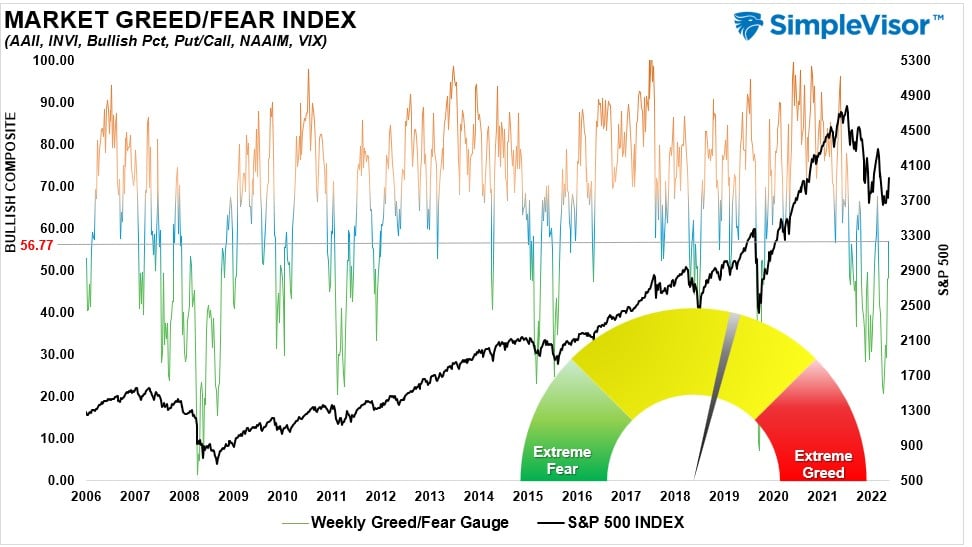
Sector Model Analysis & Risk Ranges
How To Read This Table
- The table compares the relative performance of each sector and market to the S&P 500 index.
- “MA XVER” (Moving Average Cross Over) is determined by the short-term weekly moving average crossing positively or negatively with the long-term weekly moving average.
- The risk range is a function of the month-end closing price and the “beta” of the sector or market. (Ranges reset on the 1st of each month)
- The table shows the price deviation above and below the weekly moving averages.
As we noted last week, the double-digit deviations below the long-term means in Communication, Technology, and Discretionary stocks were due to reverse as such deviations technically can not remain for extended periods. As such, the weaker inflation data sent those sectors screaming higher this week, working off most of those negative deviations. With Emerging, International, Small, and Midcaps trading well above monthly ranges, some profit-taking and rebalancing is advised.
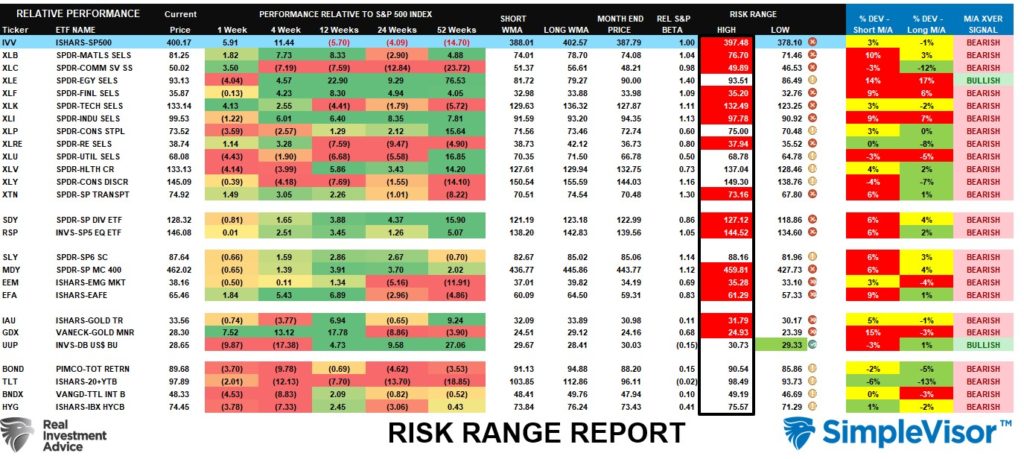
Weekly SimpleVisor Stock Screens
Each week we will provide three different stock screens generated from SimpleVisor: (RIAPro.net subscribers use your current credentials to log in.)
This week we are scanning for the Top 20:
- Relative Strength Stocks
- Momentum Stocks
- Highest Rated Stocks
These screens generate portfolio ideas and serve as the starting point for further research.
(Click Images To Enlarge)
RSI Screen
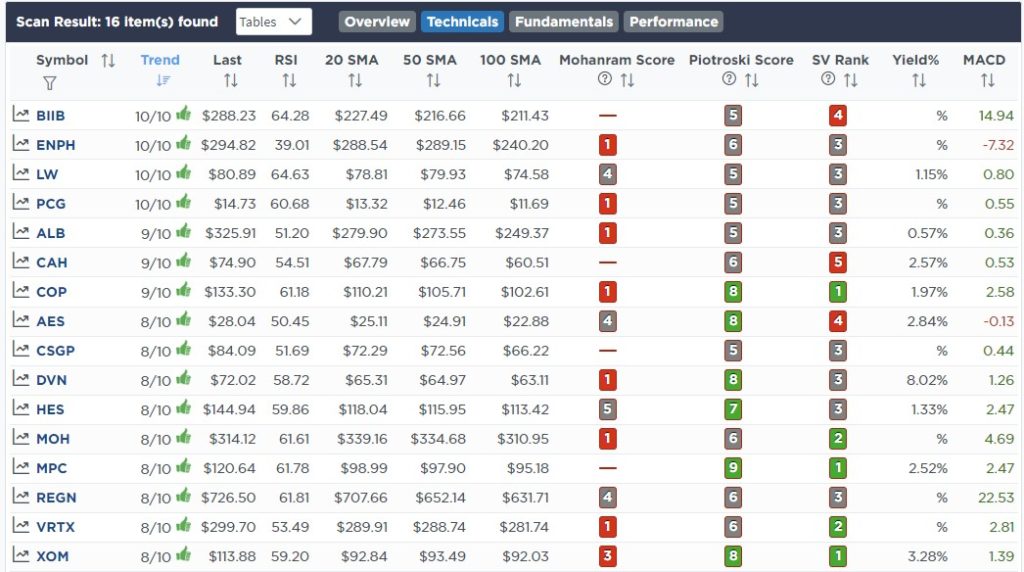
Momentum Screen
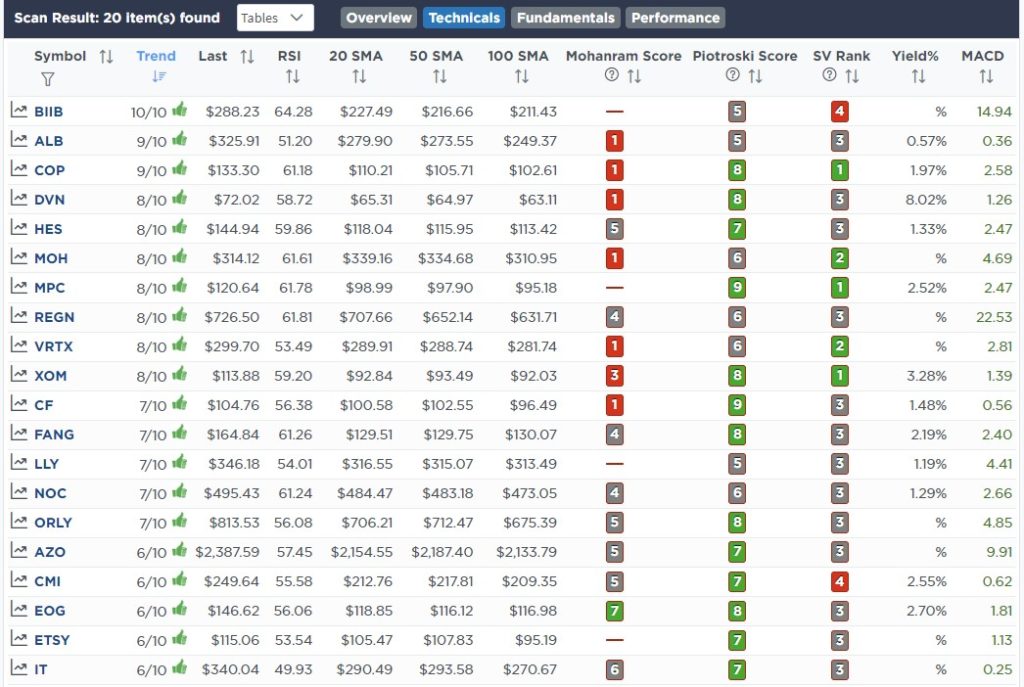
Highest Rated With Dividends Screen
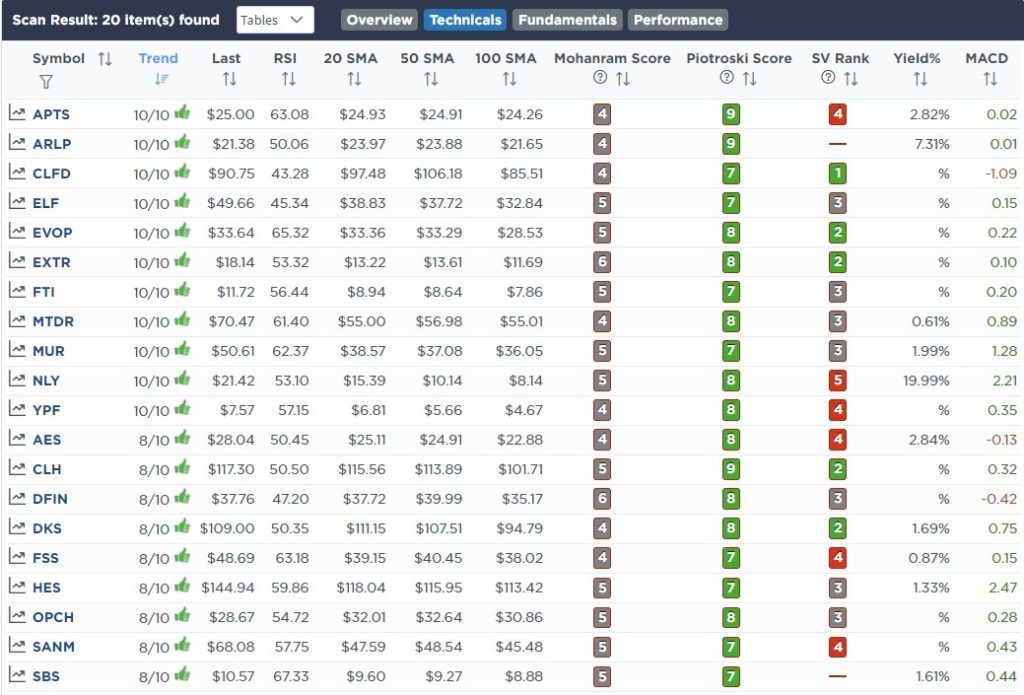
SimpleVisor Portfolio Changes
We post all of our portfolio changes as they occur at SimpleVisor:
No Changes This Week

Lance Roberts, CIO
Have a great week!





















